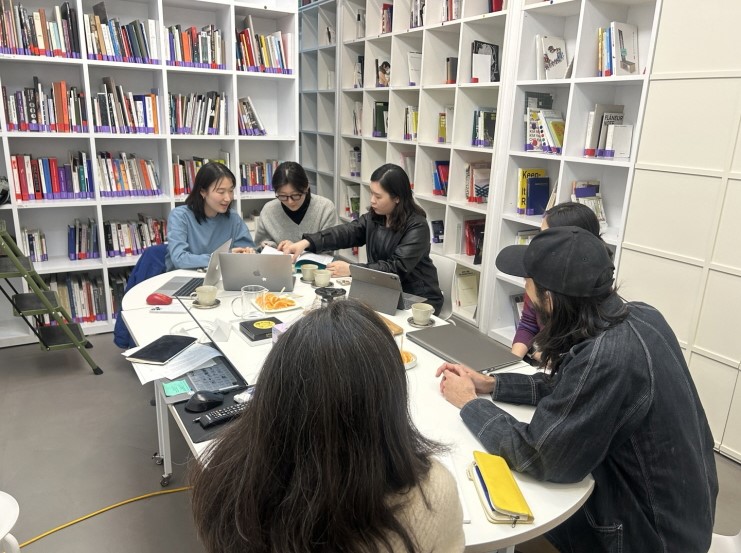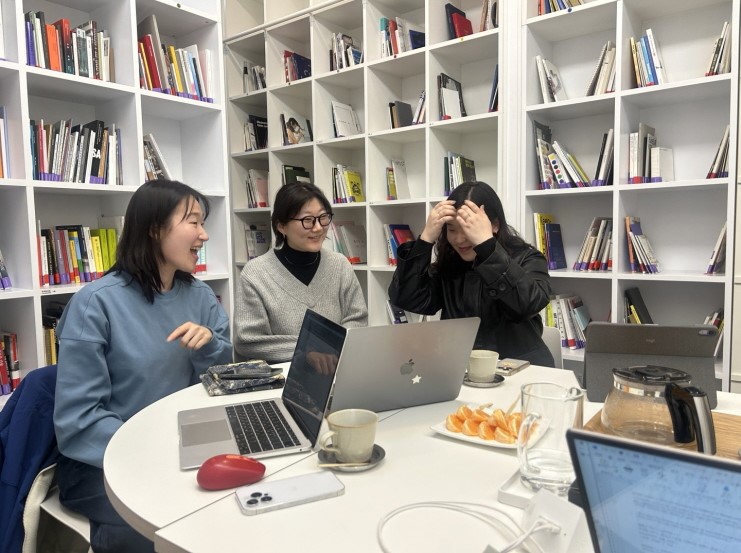Seminar Ⅰ- Binna Choi (Supervisor of DCW 2025)
Where do you come from?
While I was preparing to answer the question “Where do you come from?” I looked back on my own curatorial journey, which has been brief but also a struggle. This was an opportunity for me to look back on the things I’ve hoped for and aspired to, and my feelings about those recollections are less about “where my path has taken me and how” and more about “what direction I’ve stumbled along.” As I looked back on that experience of stumbling, the only question at the center that kept me from wavering was “Can you love again?” Can I love another person, another exhibition, another experience, another space?
In that conversation with Drew, we talked about the methods that a curator arrives at more distantly and safely (safe from obstruction by administrators and decision-makers, that is) when they speak about an event or social situation through an exhibition in a way that conveys the story strategically without necessarily giving explicit keywords to clearly signpost it. As that dialogue was unfolding, I could imagine the curator’s existence in a more concrete way than just stumbling—like a performer whose gestures assume (intentionally or otherwise) the energy and force that an exhibition is capable of harboring. So it’s an existence where you’re stumbling along some way or another as you “once again” ponder how to connect the sounds and looks created by your own gestures and faltering.
After that, we heard Binna Choi and Drew talking about the Hawaiʻi Triennial, and I had the sense that this exhibition—which I’ve never seen for myself—was raising that same question of “Can you love again?” In particular, the Hawaiian words seemed to cloak around the exhibition as they related to things like life, love, and water. In some respects, I think the sense of fatigue that I’ve gotten from other biennials and triennials in the past has come from the way they shape a vast forum of contemporary discourse where they keep poking at social issues and drawing up labels about the urgency of the “present” and what art can do there and slapping those over art’s mouth. It feels like the Hawaiʻi Triennial is creating a way of being where we’re talking about where we are coming from and why we are here again rather than declaring what needs to come right now. I also sensed that this relates in some ways to the way new land is constantly being formed by the magma that comes from Hawaiʻi’s active volcanoes. The new land we find today is not something strange that just plopped in from somewhere else—it originates in flows that have long been simmering beneath the earth’s surface. It’s about new things constantly forming over the accumulated strata of perceptions, memories, questions, and movements.
— Soojeong Park (DCW 2025)
- “No hea mai ʻoe?” (“Where do you come from?”) I’ve heard that it’s a kind of basic process and ritual for Hawaiians to begin their conversations by asking and answering this question when they meet. It’s the sort of question that inevitably takes on aspects of personal narratives relating to things like your hometown, family, language, culture, and education. It’s also a question that I would be a bit cautious about asking or answering in a society like Korea today, where people seem to regard it as a kind of virtue to conceal their backgrounds and not pry into those of others. But when I share my sculpture, I’m also preparing to share in the sculptures of others. When I internalize other people’s sculptures, I am taking on the responsibility and obligation of upholding their integrity. As we sit here talking about the places we each occupy, our individual journeys, and the parts of the world that inform us, that naturally leads to questions about how we all ended up here as people with such different lives, along with anticipation for the places we will go afterward. As we talked, I could feel a thin cord forming and winding around this loose-knit relationship. How did we find our way to this place, and where will our steps take us as the workshop continues? Is there the possibility for our steps to intersect? How much will we affect each other during this time?
- It’s the idea of valuing what’s given to you, of taking responsibility for what you receive, of caring for it while thinking of what is to come. The idea of the sharing of “kuleana” (loosely translated as “responsibility” or “duty”) as a powerful driving force binding Hawaiʻi's native community is something I observed in what I heard both from Drew Kahuʻāina Broderick and from Binna. How do you preserve the power of connection when the forces of disconnection and subversion predominate? What kinds of things can we carry on, record, and talk about in the place where we stand right now? These are the questions that have run through my head since the seminar.
— Jihee Jun (DCW 2025)
Drew said, “Words operate in places and contextual relationships, so while they might feel like they have various different meanings, they’re actually all connected and related.” So even words that seem quite different are somehow connected, and even completely separate individuals are in a sense similar. (Maybe?) During the time when we were briefly introducing ourselves, I made a point of thinking about how I am similar to these people and how I am different. There is a queer element in itself to the idea of looking at the world from an indigenous perspective, and when you talk about putting together projects outside the realm of capital and hierarchies, I superimpose my own experiences onto that. It also feels that while the words that come out of our mouths look different, the meanings within them feel in some way similar. With all those aspects of sympathy and mistranslation, the question becomes where you draw the dividing line.
I found the way the Hawaiʻi Triennial was put together to be quite fascinating, and I was curious about what it would feel like to step outside of hierarchies and become a solid team sharing a sense of commonality. Is it possible to become a unified whole without trying to escape reality or focusing entirely on the work at hand? What are the differences and similarities when it comes to identifying my own place and position and perceiving my roles and responsibilities? Once you’ve been through an experience that begins and ends with questions of turnover, where do you register yourself to come up with answers?
— Han Munhee(Amo) (DCW 2025)


